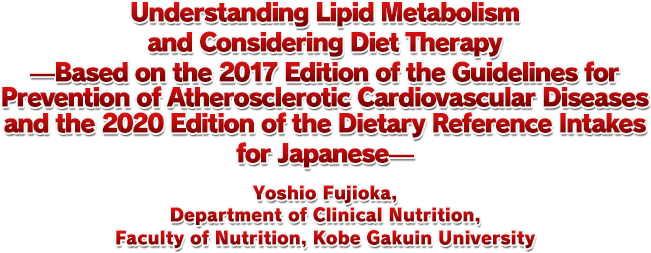|


The correction of diet and other lifestyle-related habits is essential for the prevention and treatment of atherosclerotic cardiovascular diseases. It is common knowledge among researchers that holding intervention studies is more difficult for diet therapy than for drug therapy. Furthermore, there are differences between the results of randomized controlled studies and cohort studies, which have made it difficult to clarify many points. However, based on repeated clinical research held over a period of many years, it is clearly important to understand the pathophysiology and lifestyle of each patient, to consider the details of their diet, and to evaluate and adjust the effects in a timely manner. In the sections on diet therapy in the 2017 Edition of the Guidelines for Prevention of Atherosclerotic Cardiovascular Diseases and the Guide for Diagnosis of Dyslipidemia 2018, a systematic review method that focuses on lipids is used to create diets that can be applied to Japanese people and that are actually used in outpatient treatment. Additionally, the 2020 Edition of the Dietary Reference Intakes for Japanese is based on the contents of the 2017 Edition of the Guidelines for Prevention of Atherosclerotic Cardiovascular Diseases.

For treatment, based on the knowledge of biochemical and physiological lipid metabolism that is available up to this point in time, it is necessary to know the clinically clarified effects and unclear points due to excessive or restricted intake of various fatty acids and cholesterol. However, there are many misconceptions about the relationship between diet and serum lipids. First, although individual differences are large, dietary LDL cholesterol (LDL-C) fluctuates in a range of about 7% to 13% or higher. Based on a large amount of evidence, people with high LDL-C are recommended to avoid excessive consumption of both cholesterol and saturated fatty acids. Even people with normal levels of LDL-C should be aware that continued excessive consumption will result in higher levels.

Cholesterol is synthesized throughout the body, except in some nerve cells, with the liver accounting for approximately 10% of the synthesis. On the other, the liver is responsible for 70% of regulation (intake and output) for cholesterol in serum via LDL receptors and other receptors. Lipoproteins such as chylomicrons, VLDL, LDL, and HDL are responsible for the exchange of lipids between organs. These lipoproteins invade and deposit on the walls of blood vessels, causing cholesterol that does not serve as an energy source to accumulate and ultimately causing atherosclerosis. Generally speaking, approximately 300 mg of cholesterol are consumed per day in a typical diet, while 600 mg to 1,200 mg of cholesterol are synthesized per day throughout the body. Bile acids produced from cholesterol in the liver are synthesized at a rate of 3 g per day and reused through enterohepatic circulation. In other words, the mechanism is more complex than simply stating that the amount of cholesterol consumed from food is a small ratio of the overall level and food therefore has a small impact. Additionally, unsaturated fatty acids are known for reducing LDL-C because they are being compared with saturated fatty acids and carbohydrates which provide the same energy. Accordingly, excessive consumption of unsaturated fatty acids should be avoided.
In general, for people dealing with illness related to LDL-C, diet therapy properly controls total energy intake and reduces saturated fatty acid, cholesterol, and trans fatty acid intake. In the case of hypertriglyceridemia, the total energy intake is monitored in order to maintain or pursue an appropriate bodyweight; specifically, the ratio of carbohydrates to total energy intake is set somewhat low and restrictions are placed on excessive alcohol consumption. Ideally, a registered dietitian should fulfill a central role in planning appropriate guidance on nutrition and diet by grasping the amount of physical activity, pathological condition, and nutritional status for each individual. In addition to maintaining and increasing motivation, consideration should be given to dietary patterns and therapies which are easy for dieters to understand and follow.
|